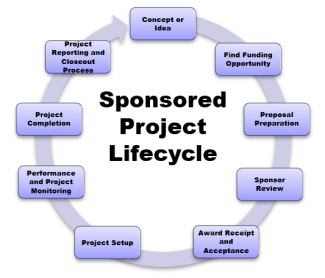Grant & Contract Administration
The research enterprise can be characterized by a “cradle to grave” process. This process begins with a concept or idea that is turned into a proposal, followed by an award, the performance of the project, and several other steps that ultimately lead to the closeout process.
Sponsored Project Lifecycle
The Office of Sponsored Programs (OSP) is the central administrative office responsible for submitting proposals and accepting awards on behalf of the MBL. Sponsored project proposals may only be submitted, and awards accepted, by individuals authorized in OSP to sign the necessary documents. Because proposals are submitted, and awards are granted to the MBL and not to individual PI’s, PI’s and administrative staff are not authorized to submit proposals, accept grants, or execute contracts on behalf of the MBL.
The Principal Investigator (PI) has the overall responsibility for the technical and fiscal management of a sponsored project, including the management of the project within funding limitations. While responsibility for the day to day management of project finances may be delegated to administrative or other staff, accountability for compliance with MBL policy and sponsor requirements ultimately rests with the PI.
Proposal Preparation
1. START EARLY!
2. Find a funding opportunity by signing into MBL’s grant software using InfoEd Spin or search using sponsor specific opportunity links.
3. Notify your Research Administrator that you plan to submit a proposal
4. Download the Funding Opportunity Announcement (FOA), also known as a Request for Application (RFA), Request for Proposal (RFP), Program solicitation or Program Announcement
5. Review Funding Opportunity Announcement for:
- Eligibility – Institution Type and PI Requirements
- Due Date
- Type of submission method
- Budget restrictions and guidelines (see Cost Sharing, Facilities & Administration Costs and Allowable Costs below)
- Earliest possible start date
- Proposal/Application Directions
6. Notify your Research Administrator if you think you need to be registered in an electronic system for proposal preparation. Your Research Administrator will notify and work with OSP for proposal set-up and submission.
7. Develop your timeline for submission (setting your final due date at least 10 business days prior to the agency deadline is suggested)
8. Develop a budget and budget justification and review with your Research Administrator
9. Working with your Research Administrator, begin the process of proposal submission via MBL’s online grant submission portal InfoEd
10. AT LEAST 10 business days prior to Sponsor deadline, submit the following to the Office of Sponsored Programs via InfoEd. Please be sure to use our MBL Grant Information Sheet for the most current rates, contact info, assurance and DUNS numbers, etc.
- Budget
- Budget Justification
- Proposal Summary Form
- Brief Project Summary or Work Scope
11. The Office of Sponsored Programs will review material submitted in #10 above and may require changes prior to submission of final application. An OSP team member will work with the Research Administrator and PI to review the submitted materials to ensure compliance with sponsor requirements.
12. AT LEAST 5 business days prior to Sponsor deadline, submit completed application to the Office of Sponsored Programs via InfoEd

What is Cost Sharing?
Cost sharing (matching funds) is any portion of a project or program that is the responsibility of the MBL and not reimbursed by the sponsor. In a proposal or an award, cost sharing represents a commitment by the Institute.
Types of Cost Sharing
- Mandatory – The sponsor requires cost sharing as a condition of the award.
- Voluntary – The sponsor does not require cost sharing as a condition of the award.
All cost sharing must be approved in advance prior to submission of a proposal. The usual policy at the MBL is to only approve cost sharing when it is specifically required by the sponsor (mandatory) and only to the level required by the agency. Volunteered cost sharing is discouraged as this has the potential to become an unnecessary financial burden on the MBL. The proposed cost sharing must be approved by the Director of Finance, and the Director of Research (for research awards) or the Chief Operating Officer (for education awards). The cost sharing will be accounted for in a separate cost center associated with the prime award. All cost sharing including “in kind” cost sharing must be documented and accounted for.
Facilities and Administrative Costs (F&A)
Research institutions are eligible for reimbursement of Facilities and Administrative costs (aka F&A or Indirect) related to federal and private grants and contracts. The Federal guidelines referenced for administration of federal awards can be found under The Office of Management and Budget’s (OMB’s) Uniform Administrative Requirements, Cost Principles, and Audit Requirements for Federal Awards:
Two components comprise the total cost of a research project: (1) direct costs and (2) facilities and administrative (F&A) or indirect costs.
- Direct Costs include those that can be identified specifically with a particular sponsored project or those that can be directly assigned to a particular project with a high degree of accuracy.
- F&A Costs are those costs that are incurred for common or joint objectives and therefore cannot be identified readily and specifically with a particular sponsored project.
F&A costs are applied on a Modified Total Direct Cost base (MTDC). The non-F&A-bearing costs in the budget must be identified so that project F&A can be accurately calculated. The MTDC base excludes:
- Equipment or Capital expenses valued at $5,000 or greater
- Subaward expenditures in excess of $25,000
- Participant Support Costs
The MBL annually negotiates its F&A rate with the Department of Health and Human Services its cognizant federal audit agency. Use the most current MBL Negotiated Rate DHHS Agreement.
Allowable Costs
The primary source for identifying costs which may be charged to grants, contracts, and other agreements is the Uniform Guidance prepared by the Office of Management and Budget (OMB). The document identifies costs that may be charged to these agreements and further clarifies which of those costs may be charged as direct costs and which may be charged as indirect costs. While not all of the projects sponsored at the Marine Biological Laboratory are federally funded, and while not all sponsors allow the inclusion of indirect costs in a project budget, the distinction between direct and indirect costs must be maintained throughout the Institution.
- All costs must be allowable under federal regulations and sponsor terms and conditions. To be allowable, cost must:
- Costs must be reasonable. Is the nature of the goods or services and the amount reflective of the action that a prudent person would have taken under the prevailing circumstances?
- Costs must be allocable. Will the cost advance the work? Is the cost beneficial and necessary to the work under the sponsored agreement?
- Costs must be treated consistently. Costs incurred for the same purpose, in like circumstances must be treated as either direct or indirect, consistently with respect to the final cost objective
Common Misconceptions
- Just because something is in the budget doesn’t mean the awarding agency allows or approves of the cost. The awarding agency relies on the recipient institution’s internal control system to ensure the costs conform to the applicable cost principles.
- Cost principles do not represent what the federal government will pay for, but rather what may be paid for – interpretation is subjective.
Responsibilities
It is the responsibility of each Principal Investigator (PI) to:
- Review sponsored research projects on a regular basis (e.g. monthly) to ensure that all expenditures charged are correct and appropriate.
- Identify and segregate unallowable costs when they are incurred and recorded.
It is the responsibility of the Office of Sponsored Programs with support from Financial Services to:
- Provide assistance in interpretation and implementation of this Policy.
- Provide training to PIs on this Policy.
- Periodically review financials to verify that charges are allowable and ask PI for necessary changes.
Unallowable cost items charged to sponsored funds that are subsequently identified during a review or audit of the project must be removed by the PI/department as soon as possible. The PI/department is responsible for absorbing these cost(s).
Definitions
An “allowable cost” is an expense which can be charged against a sponsored project as well as placed in the indirect cost rate proposal based on the following factors. The cost is:
- Reasonable – A prudent person would have purchased the item and paid that price.
- Allocable – Expenses are at least partially applicable to a sponsored agreement.
- Consistently Treated – Expenses for similar purposes must be treated the same way (throughout the MBL) under like circumstances.
- Allowable – The expense must be allowable or not specifically excluded as specified by government regulations or by the contract/grant/cooperative agreement requirements.
A “direct cost” is an expense that can be identified specifically with a particular project, such as a Federal award, or other internally or externally funded activity, or that can be directly assigned to such activities relatively easily with a high degree of accuracy. Costs incurred for the same purpose in like circumstances must be treated consistently as either direct or indirect (F&A) costs.
An “indirect (F&A) cost” is an expense that is incurred for common or joint purposes benefiting more than one cost objective, and not readily assignable to a specific project.
An “unallowable cost” is an expense that the federal government deems inappropriate and will not reimburse. These categories are identified by the Office of Management and Budget in 2 CFR 200 (Uniform Guidance) and it is the MBL’s responsibility to maintain an accounting system that clearly identifies and segregates unallowable cost categories so that they will be excluded from the MBL’s proposals for cost reimbursement.
